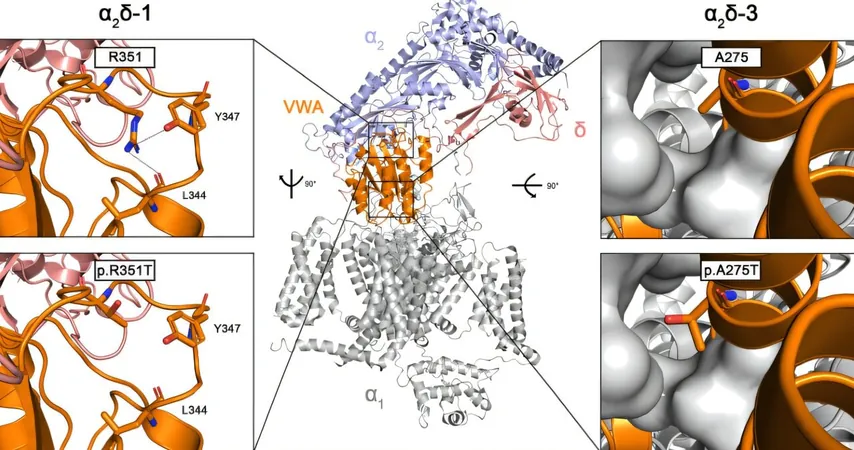
Revolutionary Study Unveils How Autism-Linked Protein Mutations Disrupt Brain Development
2025-01-29
Author: Yu
Revolutionary Study Unveils How Autism-Linked Protein Mutations Disrupt Brain Development
A groundbreaking study published in the journal *Pharmaceuticals* has revealed exciting insights into how specific genetic mutations in the proteins α2δ-1 and α2δ-3, which are associated with autism spectrum disorders (ASD), significantly impact neuronal functionality. This research highlights a remarkable reduction in these proteins' presence at the neuronal membrane and synaptic sites, without affecting their calcium channel activity or trans-synaptic signaling.
A Deep Dive into Autism Spectrum Disorder
Autism spectrum disorder is a complex neurodevelopmental condition that impacts millions across the globe, presenting challenges in communication, social interactions, and repetitive behaviors. Genetic factors are known to play a significant role in many ASD cases, with specific mutations in the CACNA2D1 and CACNA2D3 genes—coding for the α2δ-1 and α2δ-3 proteins—identified as key contributors to the disorder. These proteins are crucial in regulating calcium channels and facilitating synaptic connectivity. However, their precise contributions to ASD have remained largely ambiguous until now.
Unraveling the Mysteries of Protein Function
The Division of Physiology at KL Krems embarked on an in-depth exploration to clarify the cellular mechanisms affected by mutations in these genes. Prof. Dr. Gerald Obermair, the head of the division, commented on their findings, stating, "These revelations redefine our understanding of the role of α2δ proteins in brain development." Specifically, the study identified two mutations—p.R351T in α2δ-1 and p.A275T in α2δ-3—that notably decreased the levels of these proteins at the neuronal membrane, subsequently disrupting their synaptic localization.
First author and Ph.D. student Sabrin Haddad explained, "What is particularly striking is that, while these mutations do not seem to impair traditional calcium channel functions, their subtle changes may wreak havoc on synaptic functions." Utilizing cultured hippocampal neurons and cutting-edge electrophysiological techniques, the research demonstrated that both mutations led to significant reductions in the expression of α2δ proteins, especially in critical regions for neuronal connectivity such as dendrites and axons.
The Fascinating Role of Glycosylation
Intriguingly, the p.A275T mutation in α2δ-3 was found to affect the process of glycosylation, which is essential for maintaining protein stability and functionality. Despite the alterations in structure, the study concluded that calcium channel activity and synaptic signaling remained intact—suggesting that the real issue lies in how these mutations disrupt the architecture of synapses rather than impairing their signaling capabilities.
A Look Ahead: Implications for Autism Research
The findings indicate that the overall levels of α2δ proteins stay stable despite mutations, shifting the focus of research from traditional views centered on calcium channel dysfunction to understanding how protein mislocalization can influence neuronal networks.
“This study underscores how nuanced the effects of these mutations can be and highlights the urgent need for further investigation into their role in neurodevelopmental disorders like autism,” stated Prof. Obermair.
As researchers dig deeper into the complex genetic landscape of autism, this pivotal study adds essential knowledge regarding the underlying mechanisms of the disorder, potentially paving the way for innovative experimental approaches and novel therapeutic strategies that target the intricate biology of ASD.
Autism may seem complex, but with studies like these shedding light on its genetic foundations, the hope for better treatments and understanding grows stronger. Keep an eye on emerging research as scientists unravel the significant mysteries of autism!


 Brasil (PT)
Brasil (PT)
 Canada (EN)
Canada (EN)
 Chile (ES)
Chile (ES)
 Česko (CS)
Česko (CS)
 대한민국 (KO)
대한민국 (KO)
 España (ES)
España (ES)
 France (FR)
France (FR)
 Hong Kong (EN)
Hong Kong (EN)
 Italia (IT)
Italia (IT)
 日本 (JA)
日本 (JA)
 Magyarország (HU)
Magyarország (HU)
 Norge (NO)
Norge (NO)
 Polska (PL)
Polska (PL)
 Schweiz (DE)
Schweiz (DE)
 Singapore (EN)
Singapore (EN)
 Sverige (SV)
Sverige (SV)
 Suomi (FI)
Suomi (FI)
 Türkiye (TR)
Türkiye (TR)